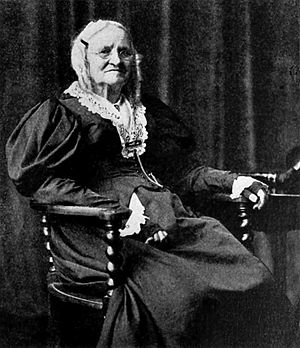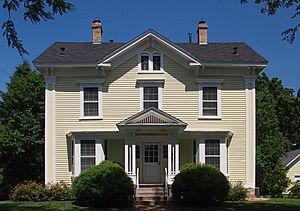Charlotte Ouisconsin Clark Van Cleve facts for kids
Quick facts for kids
Charlotte Ouisconsin Clark
Van Cleve |
|
|---|---|
 |
|
| Born | July 1, 1819 |
| Died | April 1, 1907 (aged 87) |
| Spouse(s) | Horatio P. Van Cleve |
Charlotte Ouisconsin Clark Van Cleve (born July 1, 1819 – died April 1, 1907) was an important American woman. She worked hard for women's suffrage, which means women's right to vote. She was also a social reformer in the early days of Minnesota. Charlotte was the first woman ever chosen to be on the Minneapolis School Board. She was married to Major-General Horatio P. Van Cleve. Charlotte was born while her parents were traveling to help build Fort Snelling. She lived long enough to see her small community grow into a big city.
Charlotte's Early Life
In 1819, the U.S. government wanted to protect its fur trade in the northwest. So, they sent the 5th Infantry Regiment from Detroit. Their job was to build a fort where the Mississippi and Minnesota Rivers meet. On July 1, the soldiers stopped to rest at Fort Crawford in Prairie du Chien. This place is now in Wisconsin.
A short time later, Lieutenant Nathan Clark and his wife, Charlotte Ann Seymour, had a baby girl. They also named her Charlotte. The soldiers lovingly called her a "daughter of the fifth regiment." They gave her the middle name Ouisconsin. This was a French way to spell Wisconsin, honoring where she was born. The regiment then traveled north. On August 23, they reached the spot for Fort St. Anthony. This fort was later renamed Fort Snelling.
Having a father in the army meant Charlotte moved a lot. For the first sixteen years of her life, she traveled from one fort to another. During these travels, she grew to love the military deeply. The strong feelings of patriotism and helping others that she learned there guided her whole life.
Charlotte saw many big changes as the Minneapolis–Saint Paul area grew. It changed from a quiet outpost to a busy city. In May 1823, when she was four, Charlotte saw the Virginia arrive at Fort St. Anthony. This was the first steamboat ever seen so far north on the Mississippi River. It brought important supplies for the fort. In 1862, she saw the area's first train pull into the city of St. Anthony. Later, in 1905, when she was very old, Charlotte rode in an automobile to visit the fort.
Charlotte's Adult Years
Charlotte Clark met her future husband, Lieutenant Horatio P. Van Cleve, in 1833. They met at Fort Winnebago in Wisconsin Territory. They got married on March 22, 1836, just before Charlotte's seventeenth birthday. Horatio left the military to start a new life with his wife.
For the next twenty years, the couple moved between Ohio, Missouri, and Michigan. But Charlotte missed the wide-open prairies of her childhood home. In 1856, she and her family moved back to Minnesota Territory. They settled in Long Prairie to farm. Five years later, the American Civil War began. Horatio, who was fifty-one years old, volunteered to fight. In July 1861, he became a colonel in the 2nd Minnesota Volunteer Infantry. The Van Cleves left Long Prairie and moved to Fort Snelling. Later, they moved to St. Anthony, where they lived for the rest of their lives.
The difficult years of the war made Charlotte look older. Her hair turned gray early, and her sight and hearing eventually became weak. Even with these challenges, Charlotte stayed dedicated to causes she believed in. In 1876, she became the first woman elected to the Minneapolis School Board. She used her important position to support women's causes.
Charlotte strongly supported women who needed help. In 1879, she helped start Bethany Home and became its first president. This home helped women who society looked down on, often young pregnant girls who were not married. It helped them improve their lives. Women living there stayed for a year. They received a safe place to live and learned useful skills like cooking and sewing. By 1884, Charlotte had become a powerful voice for women's suffrage (women's right to vote). She was even named an honorary vice president of the National Woman Suffrage Association. This was a big honor, even though she wasn't officially part of the group.
Charlotte's Legacy

Horatio died in 1891. Charlotte passed away on April 1, 1907, just before her eighty-eighth birthday. In February 1938, a group of high school girls formed the Charlotte Van Cleve Good Citizens Club. They did this to honor her. The club continued her good work. They gave scholarships to students who needed them. They also donated books to school libraries and helped in nursing homes.
The Horatio P. Van Cleve House is still standing today. Charlotte and her husband lived there starting in 1862. It is in the Marcy-Holmes neighborhood of Minneapolis. This house was added to the National Register of Historic Places in 1976. This was partly because of Charlotte's many achievements.

